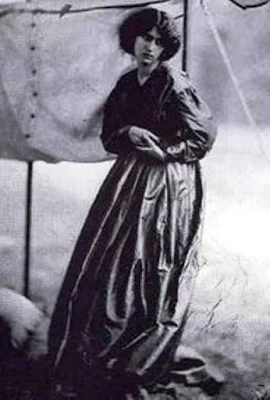Viscountess Clementina Hawarden Maude (1822-1865)
Winter: My Secret
By Christina Rossetti
I tell my secret? No indeed, not I:
Perhaps some day, who knows?
But not today; it froze, and blows and snows,
And you’re too curious: fie!
You want to hear it? well:
Only, my secret’s mine, and I won’t tell.
Clementina Hawarden's Victorian era photographs have been described as, 'erotic' and 'sensuous' because she posed her daughters in what was thought to be 'intimate' poses. She used a closet as her darkroom in her South Kensington home in London, England. She transformed the first floor of her home into a studio where,
'She disappears underneath the photographer’s black cloth, which is one with her own dark dress, as if a layer of her voluminous skirt has been pulled up and over her head. Her delicate hands, white and stained with photographic chemicals, protrude as they adjust the knobs that control the accordionlike bellows of her wooden camera. The mother tilts and focuses the image of her daughters that appears upside down on the screen at the back of her large camera box, a cabinet of sorts. The process takes several long minutes.'
While researching the life of this fascinating Victorian era woman and photographer, much was written and made about the running themes noticeable in Lady Hawarden's photographs, such phrases as: 'issues of gender, motherhood and sexuality related to the attachment of loss, illusion and even fetish!' Hawarden's photographs have been analyzed from a psychoanalytic, feminist, and cultural-historical perspective. Let's see what you think. Perhaps we can judge for ourselves or simply enjoy in the beauty of the subject matter.
Clementina
Elphinstone Fleeming was born at Cumbernauld House near Glasgow, Scotland, on
June 1, 1822. One of five children; her father, the Hon. Admiral, Charles
Elphinstone Fleeming and his wife Catalina Paulina Alessandro of Cadiz. There was a 26 year age difference between her parents and her father took part in the Venezuelan and Colombian wars of
liberation from 1811 through 1825. Little is known about her mother except for her exotic beauty.
No diaries or journals survive of Lady Hawarden’s life save for a few surviving letters which provide little insight into her life or character. She married Cornwallis Maude, 4th Viscount Hawarden, in 1845, living in London through 1857, when they moved to her husband’s family estate in Dundrum, Co. Tipperary,
Ireland.
Clementina Maude outside Dundrum Estate, Tiperarry, Ireland, 1856
It was during this time that Lady Hawarden began experimenting with photography around the Dundrum estate. In 1859 the Maude family moved back to London, England settling in at 5 Princes Gardens, South Kensington. It was here that she began photographing her daughters Clementina, Isabella and Florence mainly making stereoscopic photographs before moving to large-format, stand-alone portraits.
Clementina and Cornwallis together had ten children, two boys and eight girls, though other sources/biographies say one son and seven girls. Eight children survived to adulthood. Becoming a member of the Photographic Society of London in 1863 she later exhibited there as well, a total of two times under the titles,
‘Studies from Life’ and ‘Photographic
Studies.’ Lady Hawarden was
awarded the Society’s silver medal in 1863 and the following year.
After
suffering from pneumonia for one week, at forty-two years old, she passed away suddenly on January 19, 1865 at their home in South Kensington. Her obituary published in the British Journal of Photography on January 27, 1865, was written by photographer Oscar Rejlander,
‘worked honestly, in a good, comprehensible style she also was in her manner and conversation fair, straightforward, nay manly, with a feminine grace. She is a loss to photography, for she would have progressed. She is a loss to many, many
friends. She is an enormous loss to a loving family.’
Clementina in negligee, eyes closed, reclining on draped divan, hands folded under left cheek, 1863-4
Daughter Clementina reminds me very much in looks like Jane Burden Morris, muse of Dante Gabriel Rossetti, wife of Willaim Morris.
More photographs of Clementine. Tell me, who do you see?
Do you see the resemblance yet?
Jane Morris
Clementina Maude (daughter)
While gazing mouth agape at beautiful Clementine and Jane, I saw mainly this painting in my minds eye, Queen Guinevere by William Morris, 1858. However, this final photograph of Clementine, below, nearly knocked me off my chair...
Clementina Maude,5 Princes Gardens; Photographic Study, 1862-3. At the time, this photographed was compared to Whistler's Weary but I immediately saw Frederic Leighton's Flaming June...
Whistler's Weary sketched by Whistler The model was his mistress at the time, Jo Hiffernan, 1863
Lord Leighton's Flaming June
Essentially, I have come to realize that although beauty is in the eye of the beholder, we see what we want to see when it comes to art, photography and even the subject matter of literature. I do not see sensuality or anything immoral in Lady Hawarden's Victorian photographs. I am just grateful for the surviving works. The likes of Julia Margaret Cameron, Hill & Adamson, Talbot and Lady Hawarden, have left us with a look into the incomparable beauty that lingers within the Victorian Era. I am forever grateful!
Sources
Dictionary of Women Artists, Volume 1 by Delia
Gaze, 1997
Becoming The Photographs of Clementina, Viscountess
Hawarden by Carol Mavor, 1999
Also, I found in my research a pdf document of Lady Elizabeth Eastlake's 1857 essay, 'Photography'. It was originally published in
The London Quarterly Review, No. 101, April 1857, pp. 442-468. I have attached the entire article in a readable pdf, Photography
Photographs came from V&A and the Photographic Society of London websites
Feel free to leave comments,


















Comments
Kind regards
Kevin Marsh